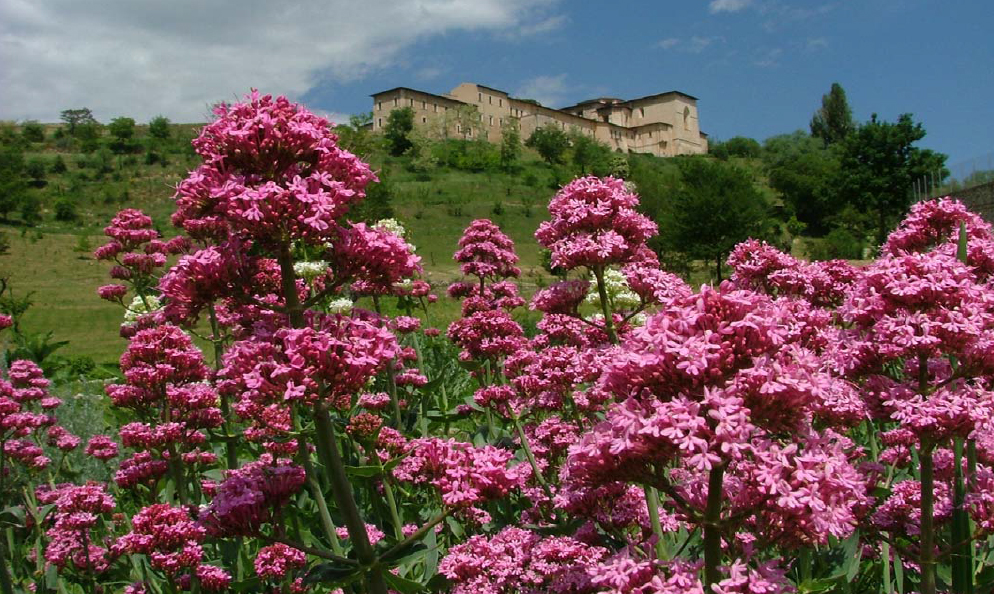
Orto Botanico di Collemaggio
This post is also available in:
 Italiano (Italian)
Italiano (Italian)
(ENGLISH TRANSLATION BELOW)
L’Orto Botanico di Collemaggio si trova in prossimità della Basilica omonima, alla periferia della città di L’Aquila. In origine l’Orto era utilizzato dai frati Celestiniani che risiedevano nella basilica passando, nel 1965, alla Facoltà di Scienze Matematiche, Chimiche, Fisiche e Naturali dell’Università degli Studi di L’Aquila. Nella parte retrostante la basilica è stato creato un giardino a carattere ricreativo e ornamentale, denominato Giardino della Transumanza in quanto anticamente costituiva il luogo di partenza del viaggio transumante verso la Puglia. L’orto ha una superficie di circa 8 ettari ed è organizzato in settori, alcuni dei quali rappresentano i principali habitat abruzzesi, mentre altri riuniscono specie con caratteristiche simili, non necessariamente autoctone. Vengono coltivate o spontaneizzate 460 specie, tra cui numerosi endemismi abruzzesi, antiche cultivar di pero, melo e ciliegio, e alcuni alberi che ospitanano il vischio (Viscum album), non diffuso negli orti botanici italiani.
Settori principali dell’Orto
Giardino delle peonie: dove le varietà presenti, erbacee ed arbustive coltivate in tutto il mondo, possono essere ammirate in tutto il loro splendore.
Succulente: coltivate in serra fredda realizzata sotto un muro, in modo da creare un ambiente riparato per la sopravvivenza alle rigide temperature invernali.
Giardino dello zafferano: per la tradizione della coltivazione dello zafferano (Crocus sativus) nella conca aquilana che risale alla seconda metà del XIII secolo.
Arboreto: realizzato in collaborazione con le 8 comunità montane che hanno provveduto a fornire le piante rappresentative del loro territorio, quali il tiglio (Tilia platyphyllos), il salice bianco (Salix alba), il faggio (Fagus sylvatica), il cerro (Quercus cerris), l’acero campestre e napoletano (Acer campestre e A. neapolitanum),bla roverella (Quercus pubescens), il carpino nero (Ostrya carpinifolia), e il pino nero (Pinus nigra).
Giardino delle farfalle: realizzato con specie attrattive come la valeriana rossa (Centranthus ruber subsp. ruber) e Buddleja davidii, soprannominato dagli inglesi come “arbusto delle farfalle”.
Olmeto spontaneo: bosco residuo costituito da olmi adulti (Ulmun minor subsp. minor) che non sono stati attaccati dalla grafiosi, malattia causata da un fungo responsabile della moria di questa specie in Europa e in Nord America.
Aiuole didattiche: zona dove sono messe in evidenza le caratteristiche morfologiche e fisiologiche della piante a scopo didattico come le piante tintorie (Isatis tinctoria, Anthemis tinctoria); e le piante tossiche (la cicuta di Socrate, Conium maculatum, e lo stramonio, Datura stramonium).
Percorso per non vedenti: camminamento con pietre in corrispondenza delle quali si trovano le piante, intervallate da colture a prato. Il cambiamento di percorso ha lo scopo di indicare al non vedente la presenza della pianta, accompagnata da apposito cartellino identificativo della specie in scrittura braille.
(ENGLISH, kindly translated and published by www.wetheitalians.com)
The Botanical Garden of Collemaggio is located near the church with the same name, on the outskirts of the city of L’Aquila. Originally, the garden was used by the Celestinian monks who lived in the basilica, and then in in 1965 it began property of the Faculty of Mathematical, Chemical, Physical and Natural Sciences of the University of L’Aquila. At the rear of the basilica a garden was created for recreational and ornamental purpose: it was called the Transumanza Garden because that was the original place of departure of the transhumant trip to Puglia.
The garden has an area of ​​about eight hectares and is organized into sectors: some of them are the main habitat of Abruzzo, while others gather species with similar characteristics, but not necessarily native. 460 different species are grown or cultivated , including many endemic species of Abruzzo, ancient cultivars of pear, apple and cherry, and some trees with mistletoe (Viscum album), which is normally not that widespread in the Italian botanical gardens.
Main areas of the Garden
Garden of peonies: where the herbaceous and shrub varieties, grown all around the world, can be seen in all their glory.
Succulent: grown in a cold greenhouse realized under a wall, so as to create a sheltered environment for the survival to the harsh winter temperatures.
Saffron Garden: for the tradition of the cultivation of saffron (Crocus sativus) in L’Aquila basin, which dates back to the second half of the thirteenth century.
Arboretum: developed in collaboration with the 8 mountain communities that have provided plants representative of their territory, such as linden (Tilia platyphyllos), white willow (Salix alba), beech (Fagus sylvatica), oak (Quercus cerris ), field and Neapolitan maple (Acer campestre and A. neapolitanum), downy oak (Quercus pubescens), hornbeam (Ostrya carpinifolia), and the black pine (Pinus nigra).
Butterfly Garden: made with species such as red valerian (Centranthus ruber subsp. ruber) and summer lilac (Buddleja davidii), named by the British as “butterfly bush”.
Spontaneous Elm Forest: consisting of elms adults (Ulmus minor subsp. minor) that have not been attacked by the Dutch elm disease, a disease caused by a fungus responsible for the mortality of this species in Europe and North America.
Flowerbeds teaching: the area where the morphological and physiological characteristics of the plants are highlighted for educational purposes such as dyeing plants (Isatis tinctoria, Anthemis tinctoria) and toxic plants (the hemlock of Socrates, Conium maculatum, and stramonium, Datura stramonium).
Path for the blind: walkway with the plants located close to stones, interspersed with grass crops. The change of path has the purpose of indicating to blind visitors the presence of the plant, accompanied by a special tag identification of the species in Braille.
This post is also available in:
 Italiano (Italian)
Italiano (Italian)
Contatti
Piazzale Collemaggio - L'Aquila()
0862 299699
ambiente@provincia.laquila.it
Altre info
Intero 3,00 euro; ridotto (ragazzi 6-14, militari, gruppi di minimo 15 persone) 2,00 euro; gratuito per bambini 0-6 e studenti universitari per motivi di studio.
Dal lunedì al venerdì.
09.00-16.00



